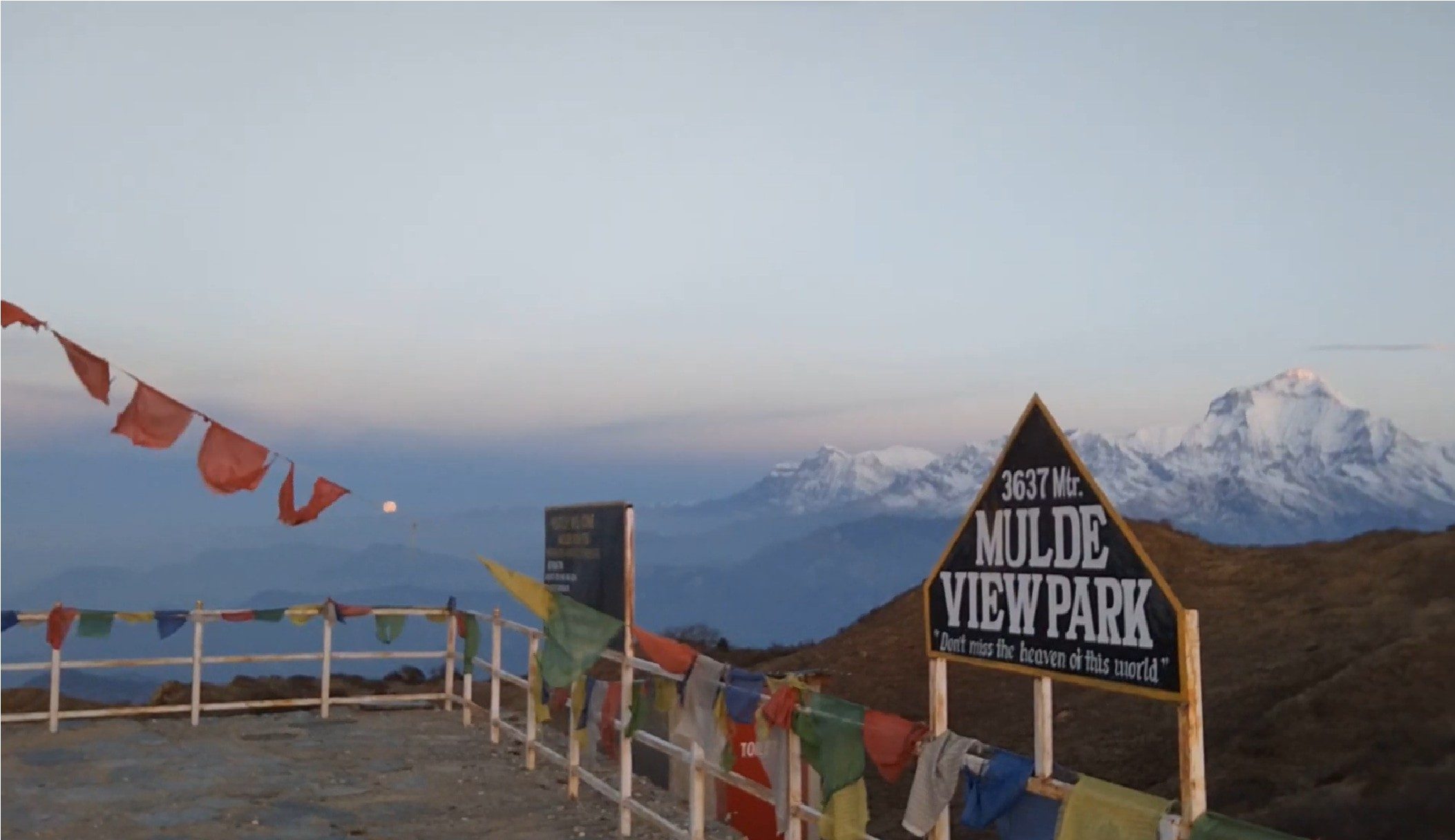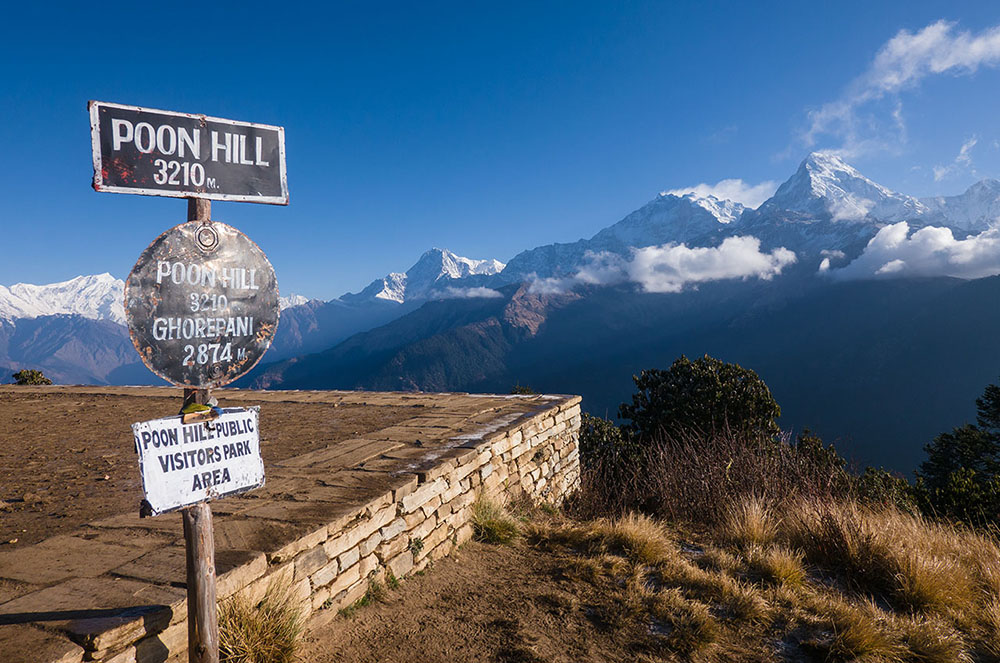
Muldai View Point and Poon Hill Trek – 7 Days
Are you an adventure enthusiast but only have a limited time and budget for exploring the natural wonders? Well, Nepal can be the perfect destination, which comes with several budget and short remote treks to fulfill your adventure thirst. Among several trekking destinations like Everest Base Camp, Annapurna Base Camp, Manaslu Circuit, and more, Muldai View Point and Poon Hill are the best budget ones.
This trek features hiking through the adventurous trails around Annapurna Region filled with the touch of a lively ecosystem. The lush green forests, wildlife including Himalayan Tahr, Snow Leopard, and Musk Deer with the views of the Himalayas, including Annapurna, Machhapuchhre, Gangapurna, and Himchuli are worth visiting.
Here are some facts you should know before hiking to Muldai View Point and Poon Hill. Have a look over it and get some insights regarding the destination:
Highlights of Muldai View Point and Poon Hill Trek
- 360 views of the snow capped peaks like Annapurna I, II, III, Gangapurna, Machhapuchhre, Himchuli, and more.
- Immerse yourself with the traditional Gurung and Thakali culture in Ghandruk and Poon Hill.
- Sightseeing at Poon Hill with the views of sunrise and the Annapurna massif.
Best Time To Do Muldai View Point and Poon Hill Trek
Trekking to remote Nepal is one of the most exciting adventures and so is Muldai View Point Trek. But what we need to do beforehand is fully prepare for the journey. Choosing the best time to do this trek comes under the same preparatory session. We will discuss when is it best to trek to this beautiful destination in the Mid-Western Nepal:
Spring Season (March to May)
Spring season lasts for three months from March to May and it is considered the ideal time to do Muldai View Point and Poon Hill Trek. This season comes with the most stable weather and climate conditions in Nepal, featuring mild temperatures, balanced humidity, and precipitation.

Poon Hill View Point
Similarly, the skies are clean and blue with fewer clouds, allowing trekkers to have a clear look of the surroundings like the Himalayas, traditional villages, and more. Similarly, there is very less chance of rainfall, making the trail crisp, which is considered best for remote trekking.
Moreover, Spring is the season of colors and the whole forest goes green and flowers bloom during this time. All these natural features offer a magnificent sphere to the journey, where trekkers can enjoy the colorful natural vegetation.
Autumn Season (September to November)
If you are looking for an alternative time to visit Muldai View Point and Poon Hill Trek, Autumn (September-November) season is the best option. The weather is stable and clear, like Spring, making it easier to see the Himalayas and local villages. It’s not too hot or cold, with less chance of rain or snow. This makes trekking in the Annapurna region safer.
Also, you can experience Nepalese culture during festivals like Dashain, Tihar, and Nepali New Year, which happen in Autumn and Spring. So, if you want a good view, nice weather, and to learn about Nepalese culture, Autumn is the best time to go.
Required Permits for Muldai View Point and Poon Hill Trek
To embark on Muldai View Point and Poon Hill Trek, trekkers need two permits. The first one is called the Annapurna Conservation Area Permit (ACAP), which can be obtained from the Nepal Tourism Board office in Kathmandu. For each person, it costs NPR 3000 [if you are an international traveler]. If you’re from Nepal, you only pay NPR 100, and for SAARC Nationals, it’s NPR 1000 per person.
The Annapurna Conservation Area is a protected place to save plants and stop fires. It’s full of forests and animals like the snow leopard and musk deer. You need the ACAP to go inside because it’s protected.
You also need a TIMS Card (Trekkers Information Management System) to trek. You get it from the Tourism Board. It’s NPR 1000 for group trekkers and NPR 2000 for solo trekkers. SAARC Nationals get discounts too, paying NPR 300 for groups and NPR 600 for solo trekkers.
Itinerary
Arrival in Kathmandu
Welcome to Kathmandu! After completing customs, a representative will be waiting to guide you through the initial cultural shock of Kathmandu’s narrow and winding alleys and check you into your hotel.
Once you’ve settled yourself, stroll out to see one of Kathmandu’s cultural highlights. Thamel, the tourist hub, is a good place to grab your first meal with a choice of restaurants serving both Western and Nepali cuisine.
-
- Accommodation
- Hotel
-
- Max. Altitude
- 1400 Meters
Fly to Pokhara (822m, 25 minutes), drive to Kimche (1,610m) 2,5 hrs, and Trek to Ghandruk (1,940m) 2 hours
Today, we will fly to Pokhara from Tribhuvan International Airport, which should take anywhere from 20 to 25 minutes. We will rest in Pokhara for sometime before carrying out our drive to Kimche at 1,610 meters above sea level.
From Kimche, we will push our hike towards Ghandruk (1,940 m), which will take only a couple of hours. The trek will take you through the rugged trails along the lush green forests. Though this might be challenging for the beginners, it still can be a very adventurous and thrilling experience. Upon reaching Ghandruk, we will stay at a guest house, enjoying Thakali and Nepali cuisine.
-
- Accommodation
- Tea House
-
- Max. Altitude
- 1,940 Meters
Trek to Tadapani (2,600m) 3 - 4 hours
Today, we will start our trek early in the morning after a warm breakfast. The motive is to reach Tadapani from Ghandruk, which takes around 3 to 4 hours. We must trek through the remote trails that stretch through the lush green forests and hills.
Once we reach Tadapani, we will stay overnight at a tea house, enjoying Nepalese cuisine, Dal, Bhaat, and Tarkari.
-
- Accommodation
- Tea House
-
- Max. Altitude
- 2600 Meters
Trek from Tadapani to Dobato (3,350m) 4 - 5 hours
After breakfast in Tadapani, we will venture off the main trail into a remote area of the Annapurna region, passing through rhododendron forests and traditional villages. As we climb uphill for around 5 to 6 hours, we will reach the lodges at Dobato, greeted by breathtaking views of the Annapurna mountain range.
We must hike through oak and rhododendron forests before arriving at Meshar Danda. Then we will continue our trek with a visit to Gurung temple. Later, we will continue our trek to Dobato from where we can have the magnificent view of Annapurna.
-
- Accommodation
- Tea House
-
- Max. Altitude
- 3350 Meters
Visit Muldai View Point (3,637m) and Trek to Ghorepani (2,874m) 4 - 5 hours
This is the fifth day of the Muldai View Point and Poon Hill Trek. We will wake up early and hike to Muldai View Point for a beautiful sunrise. From there, we can have the spectacular view of the peaks including Annapurna South, Annapurna I, and Fishtail Peak, along with other big mountains like Hiunchuli and Dhaulagiri.
After enjoying the view and taking photos, we will descend to Dobato for breakfast, then head to Ghorepani. We will retrace the same route that we followed before and walk through the rhododendron and pine forests. Upon reaching Ghorepani, we will stay overnight at a tea house.
-
- Accommodation
- Tea House
-
- Max. Altitude
- 3637 Meters
Hike to Poon Hill (3,210m), then trek to Ulleri / Hile (1,480m) 5 to 6 hours, Drive to Pokhara (822m) 2,5 hrs.
After walking for six days, we’ll reach Poonhill from Ghorepani today. It is one of the most popular destinations in Nepal bringing out the cultures of Thakali, Gurung, and Magar individuals. It is famous for its thakali food which is apparently the best. The location of Poonhill is quite high at altitude and it has wonderful views of the sun’s rising, setting, and Annapurna and Dhaulagiri mountains.
It takes about 6 hours to hike from Ghorepani to Poonhill. After enjoying Poonhill, we’ll hike to Ulleri and then take a bus back to Pokhara, where we’ll spend the night in a hotel.
-
- Accommodation
- Tea House
-
- Max. Altitude
- 3210 Meters
Drive or Afternoon flight to Kathmandu (1,400m) 25 minutes
On day fourteen of Muldai View Point and Poon Hill Trek, we will fly back to Kathmandu from Pokhara Airport at Tribhuvan International Airport. The flight takes about 20 to 25 minutes. The airline will greet you warmly and make you feel welcome during the journey.
Free day / Fly home
Today is your last day in Nepal. You’ll say goodbye to our crew who assisted you during the Muldai View Point and Poon Hill Trek. Then, you’ll take a flight from Tribhuvan International Airport back to your home country.

Your dream itinerary, crafted with you
I was born in the mountains, and raised among some of the highest peaks on Earth. I am a proud native Sherpa. My home village of Sailung, Daduwa lies in the Ramechhap District in the Eastern part of Nepal, not far from the Everest region, the world’s highest mountain.
The specialist, I design your trip to the Himalayas; I have explored and guided the country and its regions many times, and I live here. My first-hand knowledge gives you the belief that no other travel company can match our expertise in helping you plan your trip to the Himalayas of Nepal, Bhutan & Tibet.
Since its start, Magical Summits has been super-powered by you, our community; when you “travel” it, we create it. We’re on a mission to make travel better with clean, award-winning adventures that are sustainable and conscious of the planet we share.
Thank you for being a part of our journey.

Trip Designer